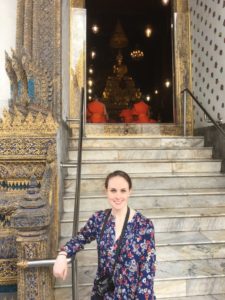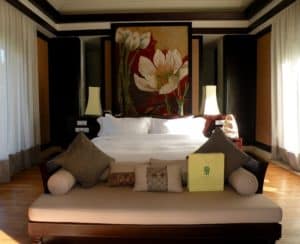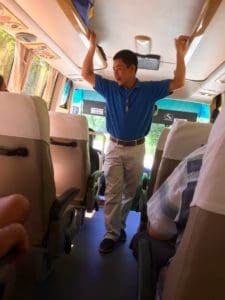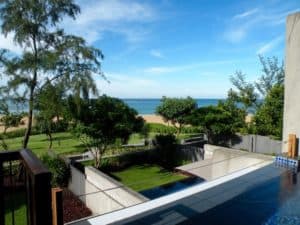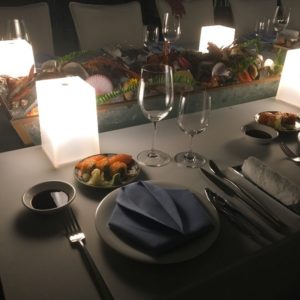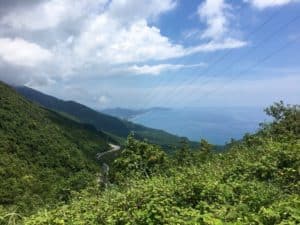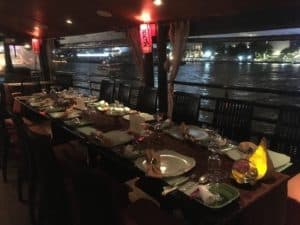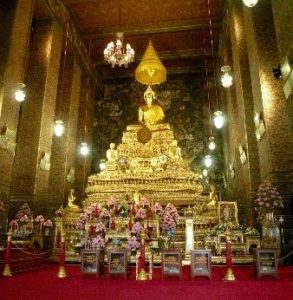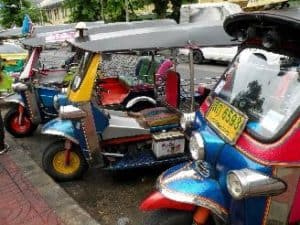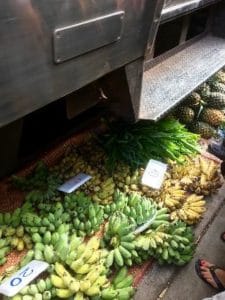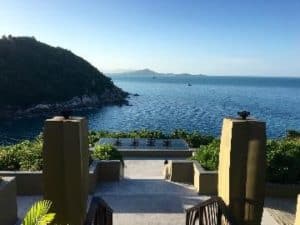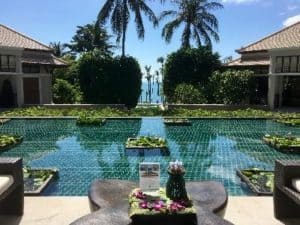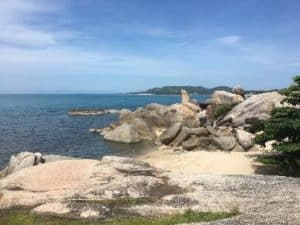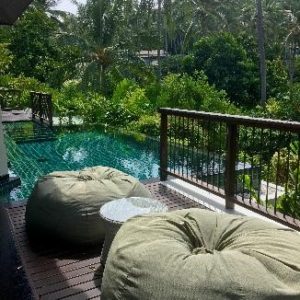I had the privilege of joining an educational familiarization trip co-hosted by Banyan Tree Hotels & Resorts and Trails of Indochina from June 10-20, 2017. We visited the countryside of Central Vietnam (we stayed in Lang Co, about 2 hours north of Hoi An and an hour and a half south of Hue), Bangkok, and Koh Samui.
I began my adventure on Korean Air from Chicago to Seoul-Incheon. Flight time was around 13.5 hours – my longest flight ever! Having not flown a long-haul flight in quite some time, I was pleasantly surprised with my roomy seat. The seats recline smoothly and have an adequate pitch, making for a comfortable journey. There was plenty of room to shift around, and although I never actually got to sleep, I was able to curl up sitting sideways in my seat without disturbing my neighbors.
Service was very good. I enjoyed the Korean Bibimbap option for lunch, and was especially tickled when they gave me a card with instructions on how to put it all together! I think it may have been pretty obvious I was not Korean…. J. We had meal service about 40 minutes into the flight, and then again about 6 hours later.
Not being able to sleep, I had plenty of time to check out the in-flight entertainment – which was extensive enough for a 13-hour flight. Options were split pretty equally between “Western” and “Korean/Asian”, which seemed to make sense as I would estimate about 75% of the passengers were Korean.
Seoul-Incheon is very clean, bright, and airy. There was a good amount of seating areas, some with electrical outlets. Also, free Wi-Fi! Dining options were a bit sparse, but adequate enough for a simple grab & go meal.
We arrived into Da Nang about 15 minutes late, and deplaned onto a bus that took us to the immigration area. The Da Nang Airport opened their brand new international terminal in early May 2017, and while they still have some logistical issues to work out, I was advised that the terminal should be fully operational by the end of July.
I had arranged to get my visa on arrival, which meant that I had to go to a desk at the back of the immigration hall, fill out the visa form, and wait about 3 minutes for the officials to print, sign, and affix the visa to my passport.
After making it through Immigration, I met my greeter & driver from Trails of Indochina outside the baggage claim. We drove up to Lang Co (it took about an hour through the newly constructed 4-mile-long Hai Van tunnel underneath the mountains), and I was welcomed warmly to the Banyan Tree.
Banyan Tree Lang Co is an all-villa property (as are the majority of Banyan Trees), which meant that as soon as you arrive to the lobby you are whisked away in a golf cart to your villa and do the check-in process there. The staff take care to show you where everything is and answer any questions you have.
I stayed in a Lagoon Pool Villa, the entry level room category that boasts over 130 sqm of living space. Each villa is free-standing, with ample amounts of greenery between villas, so the overall effect is that of privacy, tranquility, and seclusion. A private entryway leads to a very large deck with a private plunge pool overlooking the lagoon, an outdoor shower. You enter the room through the sliding glass door opposite the pool. The room is very spacious and open, well-appointed, and tastefully decorated with dark woods, contrasting the white and beiges of the linens and upholstery. Behind the king-sized bed is a large writing desk, and further on back leads to the bathroom and closet area. The bathroom has dual sinks, his & hers closets, a free-standing bathtub, and separate rain shower.
The following morning, Trails of Indochina had set up a half-day excursion to Hoi An, a UNESCO world heritage site, and about a 2 hour drive from Lang Co.
On the way, our phenomenal guide Peter told us his back-story – a tale worthy of its own feature film or novel – although I’m sure not all together abnormal for someone growing up amidst a bloody war:
He was born near Hue in 1969, during the Vietnam War. His father was in the army and died fighting the Viet Cong, and shortly thereafter his mother was “sent
away” for some sort of hard labor punishment, so Peter and his 6 siblings were brought up by his paternal grandparents. After the war, he was told he had to join the army, even after passing the exams to attend medical school. He fled to the jungle to avoid service, living rough for several years before returning to his home town, all the while dodging military service. Finally, after years of hiding from the government and military, he turned himself in – accepting that joining the army couldn’t be any worse than living off the grid constantly worried about being picked up by the police. Lucky for him, however, he had aged out and wasn’t required to serve!
Eventually, as the tourism industry began to pick up in Vietnam, he joined Trails of Indochina as a guide, and the rest, as they say, is history!
On the way to Hoi An we stopped at China Beach in Da Nang, where American troops first landed in Vietnam, as well as where at the culmination of the war the South Vietnamese were overrun by the Viet Cong.
We reached Hoi An by mid-day and walked around for a tour of the historical and cultural areas, sites including the Chinese Assembly building, and the famous Japanese covered bridge that serve as testaments to Hoi An’s history as a trading port with both local and foreign influences. Hoi An is a great town to visit a tailor for custom made garments, spend time in the shops, or simply take the time to enjoy a strong Vietnamese coffee for energy to walk around in the heat and humidity.
Later on, we headed back to Lang Co and Banyan Tree’s sister property Angsana Lang Co. The two properties, along with the Laguna Golf Club, make up the Laguna Lang Co complex along Lang Co Bay.
While Banyan Tree is an all-villa concept, Angsana is more resort-style – a very strong 4 star property geared toward families and groups. The rooms and suites are very spacious for the price point and the public spaces cater to those travelers needing a bit more excitement – with up-beat music, swim-up bars, etc.
We had dinner on the rooftop of Angsana’s beachfront restaurant, Moomba – where we enjoyed a vast smorgasbord of
fresh seafood (spiny lobsters, sushi, mussels, oysters, shrimp, sea snails, soft shell crab). The food was excellent, and the setting was exquisite – sounds of crashing waves and smooth ocean breezes complimented the meal perfectly.
The next morning, I began with breakfast at The Water Court, one of 4 dining venues at Banyan Tree (there are 4 more within the Laguna Lang Co complex, all with chargeback privileges). Normally I’m not a big breakfast person, but I could not help myself: the buffet spread was extensive, and did a very good job of combining Western staples with Vietnamese, Chinese, and Japanese cuisine.
Next, we all took buggies to Lang Co’s organic garden, where we were treated to a cooking class with the Banyan Tree’s Sous Chef. We made Vietnamese Summer Spring Rolls with dipping sauce and Bun Bo Hue, a traditional Vietnamese beef stock-based soup, typical in Central Vietnam. We all had some laughs competing over the best plating techniques and melting over hot stoves in 90+ degree heat (with about 90% humidity), and actually created some pretty tasty dishes.
Banyan Tree is known for its wellness activities – all massage therapists go through a rigorous training school in Thailand before being sent to Banyan Tree properties around the world, which means you’re likely to have a very similar high-quality spa experience whether you’re at a Banyan Tree in Vietnam, Mexico, or China. Knowing I had to experience this for myself, I chose a 90-minute Thai Classic massage that was absolutely wonderful, soothing and relaxing. My therapist, Star, incorporated some deep stretching into the massage, which was well appreciated after my combined 18-hour journey across the world.
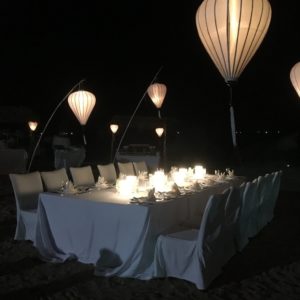 Finally, on our last night in Vietnam, we all met at Thu Quan, the lobby-side bar, for cocktails before heading down to an incredible dinner and bonfire on the beach. Once again, the food was wonderful and fresh, complete with whole fish being grilled on an open fire.
Finally, on our last night in Vietnam, we all met at Thu Quan, the lobby-side bar, for cocktails before heading down to an incredible dinner and bonfire on the beach. Once again, the food was wonderful and fresh, complete with whole fish being grilled on an open fire.
Overall, The Banyan Tree Lang Co is geared toward someone looking for a relaxing, calm vacation, but who also is interested in historical and cultural activities. The property is secluded, but without feeling cut off from city life entirely. The facilities at the Banyan Tree are impeccable, and the entire property felt like being at a spa: it’s quiet, tucked away in nature, and totally without any frenetic energy.
The next morning, we said our goodbyes to our wonderful hosts in Lang Co and boarded the bus for our drive back to Da Nang. This time, however, instead of going through the Hai Van tunnel, we made our way to Da Nang on Hai Van pass road, a winding, two-lane road through the mountains that used to be the only connection between Da Nang and Hue. Before the tunnel underneath the mountain was built and opened in 2005, the pass created terrible congestion going both ways, and getting to the airport from Lang Co could take up to 6 hours!
These days, as the majority of traffic (especially trucks and buses) use the tunnel, taking the pass from Lang Co to the Da Nang Airport only adds about 30 minutes
to the journey. It offers incredible views over the South China Sea, but I would strongly advise against it for people with aversion to heights or who get car sick easily.
We flew Bangkok Airways for the 1.5 hour flight from Da Nang to Bangkok. Known as “Asia’s Boutique Airline,” Bangkok airways serves a full hot meal even on short-haul flights, the speed and efficiency of the service is quite impressive!
Upon arrival into Bangkok Suvarnabhumi Airport, we sped through the Priority Lane for immigration formalities, picked up our luggage, and boarded a private bus for the 20 mile drive into Bangkok-proper. I say 20 miles, because depending on traffic, this journey can take anywhere from 30 minutes to 1.5 hours.
That night, after private check-in on the Club Floor, we got to experience Banyan Tree Bangkok’s exclusive Apsara Dinner Cruise on the Chao Phraya River that runs through Bangkok. The hotel owns its own converted traditional rice vessel on which guests can enjoy the Bangkok nighttime scenery while consuming a menu of Thai culinary classics.
As I had Club Access, I chose to have breakfast on the Club Floor to fuel up for a full day of touring in Bangkok. The spread was very similar to breakfast in Lang Co, a whole table of pastries, a wall of fresh fruit, help-yourself fridges with juices, milk, and water, an egg-man making custom omelets, and tables of salted & cured meat and fish, assorted cheeses, and hot dishes ranging from Chinese steamed pork buns to Indian curries with rice.
We then hopped on the bus by 8 am in order to catch morning prayers at Wat Pho, one of the oldest temples in Bangkok. While we only stayed listening to the
monks chanting for about 5 minutes due to time constraints in our busy schedule, I could have sat there for at least an hour. Bangkok had already been a chaotic shock to my system after spending 3 relaxing days in rural Vietnam, and I relished the sense of calm.
After being plucked from the serene temple, back we went into city-life as we made our way over to view the massive Reclining Buddha. Despite the growing amount of tourists by that time, I was able to appreciate the grandeur of one of the largest Buddha statues in Thailand: measuring almost 50 feet long and 10 feet high.
Next, we hopped into tuk-tuks, motorized three-wheeled versions of the old rickshaw, and were driven through the Kak Klong Taland Flower Market. Tuk-tuks are a very common form of transportation in Thailand, especially in large metropolitan areas like Bangkok where traffic congestion is horrendous. Seeing Bangkok from the seat of tuk-tuk endeared me a little more to the hustle and bustle of the sprawling metropolis.
Our guide, Sue, did an excellent job of moving the group through the crowded streets and over to the pier, where our very own long-tailed boat awaited to take us through the khlongs (canals) of Thonburi to observe local life up close.
Our boat took us away from chaos along the Chao Phraya and into the canals, where life, at least from the seat of a 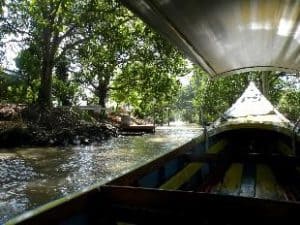 passing boat, seemed a bit more calm. Nevertheless, the boat-ride in the khlongs allowed for a glimpse of the contrasts of life in Bangkok: ornate temples wedged between two ramshackle houses.
passing boat, seemed a bit more calm. Nevertheless, the boat-ride in the khlongs allowed for a glimpse of the contrasts of life in Bangkok: ornate temples wedged between two ramshackle houses.
After lunch we sauntered through Chinatown (part of Old Bangkok) and its extensive markets. Well, I should actually say we sauntered through parts selling flowers, spices, and textiles, but walked briskly through the raw meat and fish parts. Call me new-fangled, but I just don’t think slabs of meat and fish should be out in open air when it’s nearly 95 degrees!
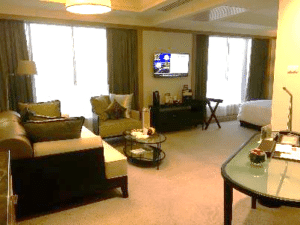 I stayed in Serenity Club Room, the only non-suite accommodation to offer Club Access. Even coming from Lang Co with almost 130 sqm of living space, the living/bedroom area was very spacious for a city hotel – about 48 sqm. Nearly one full wall was windows, which in my case offered a very nice view of the river. Décor is tasteful and elegant, with mostly whites and light greys in the linens and upholstery. All in all, I would give the room product 4 out of 5 stars, docking one star for a slightly awkward bathroom layout.
I stayed in Serenity Club Room, the only non-suite accommodation to offer Club Access. Even coming from Lang Co with almost 130 sqm of living space, the living/bedroom area was very spacious for a city hotel – about 48 sqm. Nearly one full wall was windows, which in my case offered a very nice view of the river. Décor is tasteful and elegant, with mostly whites and light greys in the linens and upholstery. All in all, I would give the room product 4 out of 5 stars, docking one star for a slightly awkward bathroom layout.
Bangkok is one of three city properties in the Banyan Tree hotel portfolio (the others being Shanghai and Macau), and 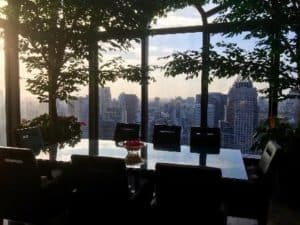 once you explore a bit inside the property, the spaces do have that typical relaxation/spa feel that is indicative of the Banyan Tree brand. First of all, the rooms are very large, the smallest being 44 sqm, so you don’t get the cramped feeling of being in a huge metropolis and can almost forget the gridlock hundreds of feet below you! Square footage in the One & Two Bedroom Suites jumps up to 75sqm and 130 sqm, respectively, and that extra footage is well spent in the bathrooms which have a much more open layout than the rooms. The Presidential Suite is exceptional- complete with a spiral staircase leading to the master bedroom, huge living room, and 8-seat dining table with spectacular views of the city.
once you explore a bit inside the property, the spaces do have that typical relaxation/spa feel that is indicative of the Banyan Tree brand. First of all, the rooms are very large, the smallest being 44 sqm, so you don’t get the cramped feeling of being in a huge metropolis and can almost forget the gridlock hundreds of feet below you! Square footage in the One & Two Bedroom Suites jumps up to 75sqm and 130 sqm, respectively, and that extra footage is well spent in the bathrooms which have a much more open layout than the rooms. The Presidential Suite is exceptional- complete with a spiral staircase leading to the master bedroom, huge living room, and 8-seat dining table with spectacular views of the city.
Banyan Tree Bangkok has 9 dining venues, with cuisines ranging from Thai to Japanese to Cantonese, the most impressive of which is Vertigo and Moon Bar on the rooftop, 61 stories above the traffic congestion and offering 360 degree views of the city. We had our final dinner in Bangkok here, and the meal was almost as spectacular as the vistas.
On our last morning in Bangkok, we were up bright and early off to visit some of Thailand’s more eccentric market experiences. About an hour outside of Bangkok is Maeklong, a town that has developed its central market on working train tracks. And when I say ON the tracks, I mean ON the tracks themselves. A couple minutes before a train arrives, warning bells sound and vendors fold up their umbrellas and move their wares from the tracks to just to the side of the tracks. Tourists such as ourselves cram their backs against store windows as the train enters the station and watch as it passes just inches from their noses. Certainly an experience not to forget! We were told that the reason for this special location was that as the tracks are on public land, the vendors don’t have to pay rent for the extra space. The market itself was pretty typical of Asian markets, lots of fruits, vegetables, some textiles, etc.
After a quick stop at a local grocery for cold drinks we were back on the bus to one of the Bangkok area’s more famous markets – the Damnoen Saduak Floating Market – built on and alongside the Khlong (canal) of the same name. We took a 15-minute speedboat ride to the market itself, where we admired the scenery and houses alongside the canal. The Floating Market is known as a tourist trap, but also an interesting way to see how businesses popped up despite the lack of streets and roads.
Then it was back to the bus to head to the airport for our afternoon flight to Samui. I can imagine Bangkok Suvarnabhumi Airport can be pretty daunting for lone traveler, but Trails of Indochina made the experience nearly effortless and hassle-free. We again flew Bangkok Airways. In Bangkok offers a lounge for its passengers in economy (there is a separate lounge for Business & First Class passengers), which along with the hot-meal service on the 45 minute flight, is very impressive.
Samui Airport is a tiny airport servicing the entire island, and was built by Bangkok Airways, so they operate an almost full monopoly on the flights to and from there. It has 4 terminals, and is pretty much in open air (and without air conditioning). Bussing is, of course, a must to transport passengers from the planes to the terminals.
We were met at the airport by our Samui guide, Ton, and took a 30 minute van ride to Banyan Tree Samui, situated on the East side of the island between Chaweng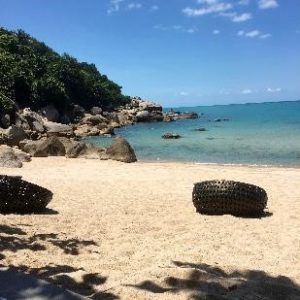 and Lamai Beaches (the main tourist thoroughfares. Its location is optimal, as it is nestled above a cove that’s flanked on both sides by high rocky cliffs, making the beach virtually private. All the beaches on Samui are public, which means that any vendor, tourist, or other strange person could wander in front of your sun lounger at any other beach property, but not Banyan Tree. It’s virtually impossible to get to the beach other than by boat (or through the resort itself).
and Lamai Beaches (the main tourist thoroughfares. Its location is optimal, as it is nestled above a cove that’s flanked on both sides by high rocky cliffs, making the beach virtually private. All the beaches on Samui are public, which means that any vendor, tourist, or other strange person could wander in front of your sun lounger at any other beach property, but not Banyan Tree. It’s virtually impossible to get to the beach other than by boat (or through the resort itself).
True to the Banyan Tree brand, seclusion among nature is the name of the game. This was even more evident when first setting foot on the property – the lobby area has spectacular views of the cove when you first walk in, which as far as first impressions go, is one of the best arrivals to a hotel I’ve ever had.
I stayed in a Deluxe Pool Villa, the entry-level category villa in the property. With 130sqm divided between three separate areas (sitting room, bedroom, bathroom, all able to be sectioned off by sliding doors), along with a huge deck with table and chairs, outdoor sofa lounger, and a plunge pool stretching almost the entire side of the living space, I couldn’t have asked for better accommodations at the end of a long trip.
Since I never quite adjusted fully to the time zone, I decided to use one morning to try out one of the complimentary yoga classes. The yoga studio at Banyan Tree Samui is quite small; there was only room for 4 mats plus the instructor, so I recommend contacting your Villa Host once you have classes in mind.
Afterward, I popped over to the Spa Reception to get started with the signature Rainforest Hydrotherapy Session. For
about an hour I was led through a journey through the “Rainforest”, hitting steam rooms, cold bucket showers, sauna, and several different water jet stations in the Rainforest pool, all to end up wrapped up on a heated stone bed drinking ginger tea. The experience was both fun and relaxing, and would be excellent coupled with one of Banyan Tree’s wonderful massages for a luxurious spa day.
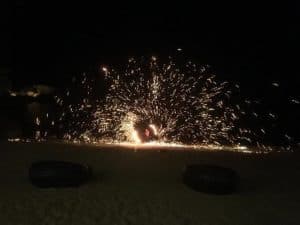 After a day spent relaxing and enjoying the resort facilities, we spent cocktail hour sipping delicious Tom Yums (a take on the traditional Thai Tom Yum soup in cocktail form) while watching the sun set over the cove. We then headed over to International Barbecue Night at Sands, Banyan Tree Samui’s beachside restaurant. The serve-yourself spread featured a grill station offering lobster, lamb, steak, shrimp, and every other carnivore’s desire. The pièce de resistance of the evening, however, was the fire dancer who came out and dazzled us with a fire show sure to please even the pickiest of pyromaniacs.
After a day spent relaxing and enjoying the resort facilities, we spent cocktail hour sipping delicious Tom Yums (a take on the traditional Thai Tom Yum soup in cocktail form) while watching the sun set over the cove. We then headed over to International Barbecue Night at Sands, Banyan Tree Samui’s beachside restaurant. The serve-yourself spread featured a grill station offering lobster, lamb, steak, shrimp, and every other carnivore’s desire. The pièce de resistance of the evening, however, was the fire dancer who came out and dazzled us with a fire show sure to please even the pickiest of pyromaniacs.
On our last day together, we spent the morning circumnavigating the island, visiting several of Samui’s highlights. First
stop was Hin Ta & Hin Yai Rocks, otherwise known as Grandfather and Grandmother Rocks. According to Samui folklore, a husband and wife set sail with the intent to arrange a marriage for their son, but encountered a storm typical of the Samui rainy season and perished at sea. Legend has it that their spirits were turned into the Hin Ta and Hin Yai rocks, which bear a not so subtle resemblance to male and female anatomy as “proof to the would be bride’s parents of their true intentions.”
We made our way clockwise around the island, stopping at several community temples (Wats).
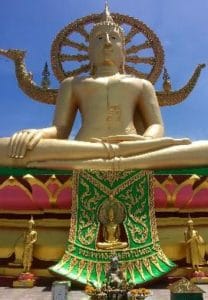 Our last stop before lunch was at the temple of Big Buddha, Wat Phra Yai, located on the small island of Koh Fan just off the northwest corner of Koh Samui. Here, after ascending an ornate stairsay, we were granted spectacular views of the sea and the nearby island Koh Pha Ngan.
Our last stop before lunch was at the temple of Big Buddha, Wat Phra Yai, located on the small island of Koh Fan just off the northwest corner of Koh Samui. Here, after ascending an ornate stairsay, we were granted spectacular views of the sea and the nearby island Koh Pha Ngan.
After an incredibly delicious set lunch in the Fisherman’s Village along Bo Phut Beach, we drove through the main thoroughfare of Chaweng Beach (the commercial center and height of the “action” on the island) for some photos, and then continued back to the Banyan Tree.
After over a week together that flew by, we all sat down for Farewell Dinner at Saffron (Banyan Tree’s signature Thai restaurant), which is perched atop the cliffs overlooking the private cove – and where I’m told is the best place to watch the sunrise. Again, the food was excellent, and we were especially appreciative that this dining venue was not completely open-air (unlike Sands on the beach), as there was a short tropical downpour for about 20 minutes during dinner.
Due Korean Air’s schedule out of Bangkok, I was one of the few in our group who didn’t have an early morning departure out of
Samui, so I spent the morning and early afternoon relaxing in my villa and packing, and then transferred to the airport around 3:30 pm – ready for the 3 flights that would take me back home to Chicago.


